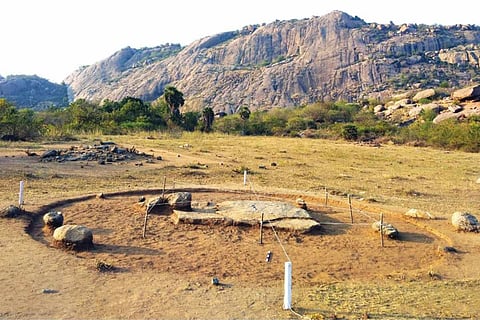

Radiocarbon dating of excavations from Mayiladumparai in Krishnagiri district confirmed that iron was in used in Tamil Nadu as early as 2172 BCE — or 4,200 years ago — making it the oldest iron age site currently found in India, Chief Minister MK Stalin announced in the state Assembly on Monday, May 9. The result has affirmed that iron was in use in Tamil Nadu as many as 4,200 years before present times, he said, calling it a matter of pride, amid the thumping of desks by MLAs. This is also a clear answer to questions on the origins of agrarian society in Tamil Nadu, Stalin said, recalling that farming activities took shape after the realisation of the uses of iron.
The findings from excavations by Tamil Nadu’s Department of Archaeology at a habitation site located at Mayiladumparai are the latest in a series of intriguing findings from archaeological sites like Keezhadi, Adichanallur and others. “The history of the Indian subcontinent should henceforth commence only from the Tamil landscape and the government is working towards scientifically establishing it through evidence,” Stalin said. The excavations have led to three major findings — that the Iron Age in Tamil Nadu has been identified as early as 2172 BCE; that the late Neolithic phase (or the last part of the Stone Age) has been identified before 2200 BCE; and that black-red pottery was introduced in the late Neolithic phase itself and not in the Iron Age.
The habitation-cum-burial site in Mayiladumparai was first excavated in the year 2003 by K Rajan of the Thanjavur-based Tamil University and based on his promising results, excavation was resumed in 2021 by the state Department of Archaeology, according to its report on the Mayiladumparai findings.
Two samples were sent from the Mayiladumparai site for radiocarbon dating by Accelerator Mass Spectrometry (C14-carbon dating) method, to Beta Analytic Testing Laboratory in Florida, USA. The AMS dates for these objects date to 2172 BCE and 1615 BCE, according to the report, which said that with the introduction of iron at this time, “the seed and the foundation for the development the of Sangam Age around 600 BCE is laid about 4,200 years ago.”
Before Mayiladumparai, the earliest evidence of the use of iron in Tamil Nadu was found at Mangadu near Mettur in the Salem region, dated to 1510 BCE. The use of iron has been found to have begun much earlier in other parts of India, with the earliest iron use found in Karnataka’s Brahmagiri dated to 2040 BCE, according to the Department of Archaeology’s report on the Mayiladumparai findings.
With the iron artefacts found at Mayiladumparai dating to 2172 BCE, the new finding pushes the start of the Iron Age in Tamil Nadu to more than six centuries earlier than what was understood so far.
Out of the 28 AMS-based dating of Iron Age sites in India, this is the earliest, CM Stalin announced on Monday. The 28 sites include Mayiladumparai and others in Tamil Nadu besides those in Karnataka, Andhra Pradesh, Uttar Pradesh, Maharashtra, Madhya Pradesh, West Bengal and Jharkhand.
Apart from providing indications for understanding the start of iron use, the excavations have also helped understand the transformation from the late Neolithic phase to the Early Iron Age. It has been identified that the late Neolithic phase in Tamil Nadu started before 2200 BCE, based on a cultural deposit of 25 cm below the dated level, the report said.
It has also been ascertained that black-red pottery was introduced here more than 4,200 years ago, during the later stages of the Neolithic Age, Stalin said. This is in contrast to the wider belief that black-and-red ware was introduced in the Iron Age, the report said.
CM Stalin said that further excavations would be carried out in sites that have a connection to Tamil people — like those in Kerala (Pattanam), Karnataka (Talakadu), Andhra Pradesh (Vengi) and Odisha (Palur) — to trace the journey of ancient Tamils.
A preliminary underwater archaeological survey would begin this month at the Sangam-era port of Korkai, he said. Stalin also said the state archaeology department would this year begin a comparative study plan of signs found in pottery shreds discovered in Tamil Nadu with that of seals of the Indus Valley Civilisation.
Last year, findings from archaeological excavations in Sivakalai, Thoothukudi district indicated that there was possibly a city civilisation in south India as long back as 3,200 years ago, the later part of the Indus Valley Civilisation. It was said that these findings could potentially establish a connection between the Indus Valley Civilisation and Tamil civilisation. Earlier, the findings from the fifth phase of excavation in Keezhadi in Sivaganga district also included a possible link between the Indus Valley civilisation and Tamil civilisation through their scripts.
With PTI inputs